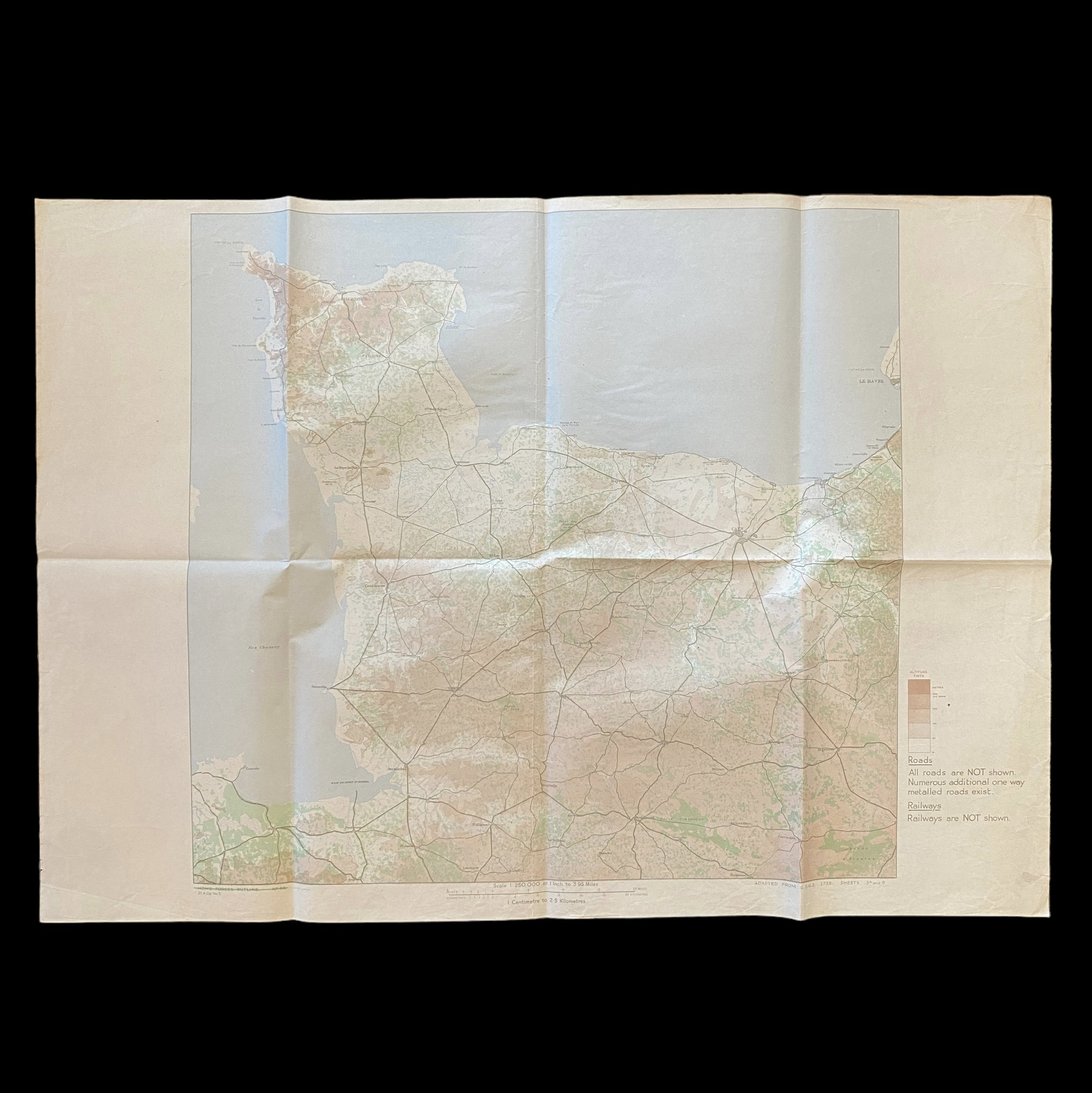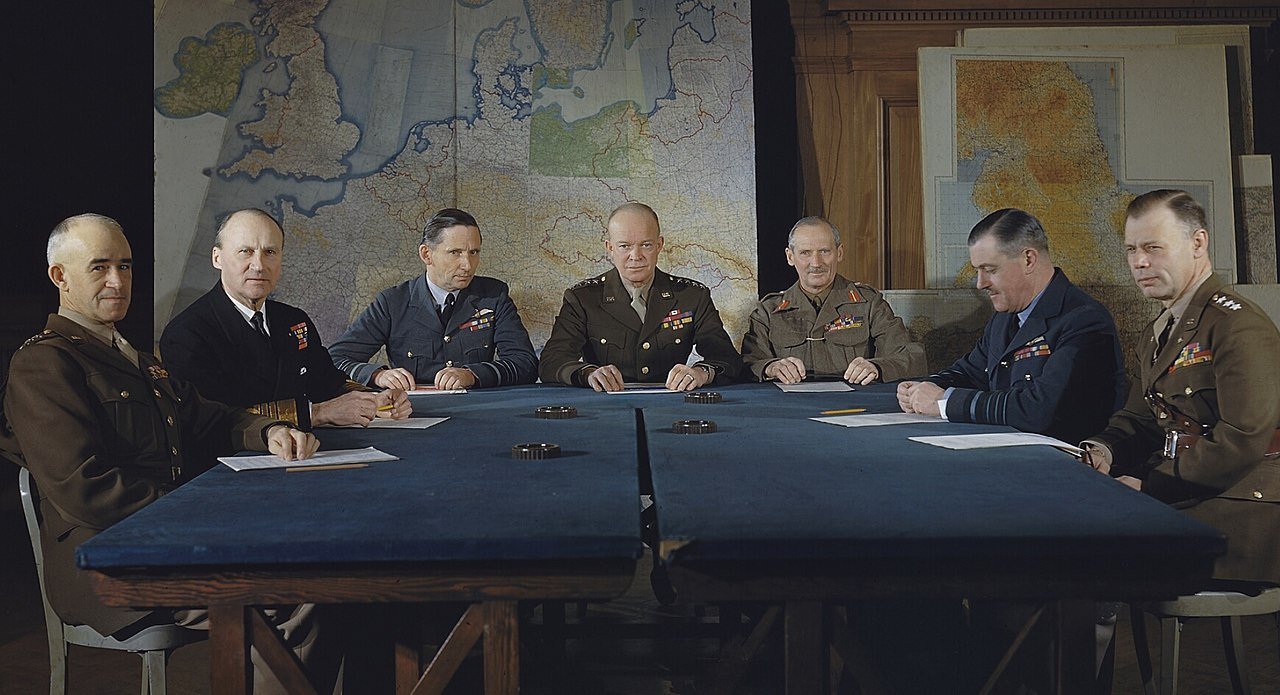VERY RARE! WWII Operation Overlord S.H.A.E.F. Headquarters 21st Army Group D-Day Planning Map (UTAH, OMAHA, GOLD, SWORD, & JUNO)































VERY RARE! WWII Operation Overlord S.H.A.E.F. Headquarters 21st Army Group D-Day Planning Map (UTAH, OMAHA, GOLD, SWORD, & JUNO)
Comes with a hand-signed C.O.A.
This extremely rare and museum-grade WWII Operation Overlord D-Day invasion map vividly illustrates the intensive planning and operational accuracy that was behind Operation Overlord and the largest amphibious seaborne invasion in history. This very low print count map is dated 1943 and was created in conjunction with the TOP SECRET BIGOT maps and was made by and for the 21st Army Group during the planning of Operation Neptune and Operation Overlord. This 21st Army Noramdny coast map was used for the strategic planning of Operation Overlord and shows all five of the D-Day amphibious landing beaches of UTAH, OMAHA, GOLD, SWORD, & JUNO BEACH.
Commanded by General Sir Bernard Montgomery, 21st Army Group initially controlled all ground forces in Operation Overlord (the United States First Army and British Second Army). When sufficient American forces had landed, their own 12th Army Group was activated, under General Omar Bradley, and the 21st Army Group was left with the British Second Army and the newly activated First Canadian Army which, despite its title, also contained many British and Polish troops.
Normandy was a battle of attrition for the British and Canadian troops, drawing in most of the available German reinforcements, especially armoured divisions, around Caen at the eastern end of the lodgement. These operations left the Germans unable to prevent the American breakout at the western end of the Normandy beachhead in early August 1944. Following the German attack towards Mortain, the American breakout and an advance by the 21st Army Group the German armed forces in Normandy were nearly enveloped in the Falaise pocket, and subsequently routed, retreating towards the Low Countries.
The planning for Operation Neptune began in 1943 when Allied leaders began discussing the possibility of a large-scale invasion of Europe. The planning involved a wide range of military, political, and logistical considerations, including the selection of a suitable location for the invasion. Several potential landing sites were considered, including Pas-de-Calais, Brittany, and Normandy. Pas-de-Calais was the closest point to England and was heavily fortified by the Germans, making it a risky choice for the invasion. Brittany was another potential location, but it was farther from England and lacked suitable ports for the large-scale landing of troops and supplies. Ultimately, Normandy was selected as the location for the invasion due to its relative proximity to England and its suitability for a large-scale amphibious landing. Once Normandy was selected, the planning process intensified. The invasion required a massive buildup of troops, equipment, and supplies, which had to be coordinated and transported across the English Channel. The logistics of the operation were complex and required the construction of temporary harbors, known as Mulberries, to enable the rapid offloading of troops and supplies.
The planning for the invasion also involved extensive reconnaissance of the Normandy coastline. Allied intelligence officers gathered information on the German defenses, including the locations of bunkers, artillery positions, and minefields. This information was used to develop detailed invasion plans, which included the selection of landing sites, the timing of the attack, and the deployment of troops. In addition to military planning, Operation Neptune also involved extensive political coordination. The invasion required the cooperation of multiple Allied nations, including the United States, Great Britain, Canada, and others. This coordination involved the allocation of troops and resources, as well as the establishment of a unified command structure.
As the date of the invasion approached, the preparation intensified. The troops were trained and equipped, and final preparations were made for the landing. The weather was a significant factor in the planning, and the invasion was delayed several times due to adverse weather conditions. Despite the challenges and risks involved, the planning and preparation paid off, and the Allied forces were successful in their invasion of Normandy. The invasion marked a turning point in the war, and it helped to pave the way for the eventual defeat of Germany.
The planning and preparation that went into Operation Neptune were extensive and complex. The selection of Normandy as the location for the invasion was the result of careful consideration of a range of factors, including geography, military strategy, and logistical considerations. The success of the invasion was due in large part to the meticulous planning and preparation that went into it, as well as the bravery and dedication of the Allied troops who carried it out.
The D-Day Normandy landings on June 6th, 1944, were one of the most critical events of World War II. The invasion, codenamed Operation Overlord, marked the beginning of the liberation of Europe from Nazi Germany. It involved a massive amphibious assault by the Allied forces on the beaches of Normandy, France. The invasion was divided into five sectors, with the Americans landing on Utah and Omaha Beaches. The operation was meticulously planned and executed, but it was far from easy. The soldiers had to face fierce resistance and risk their lives to achieve their objectives.
Planning for Operation Overlord began as early as 1943. The objective was to create a second front in Europe to relieve pressure on the Soviet Union in the east and force Germany to fight a two-front war. The Allies planned to land on the Normandy coast, establish a beachhead, and advance inland to capture key objectives, including the port of Cherbourg, to supply the invasion forces. The operation required a massive amount of resources, including troops, equipment, and supplies. The Allies built an elaborate deception plan, known as Operation Bodyguard, to convince the Germans that the invasion would take place elsewhere.
The operation was scheduled for June 5th, but bad weather forced a delay of 24 hours. On June 6th, the invasion force, consisting of over 150,000 soldiers, 5,000 ships, and 11,000 aircraft, set sail for Normandy. The American forces landed on Utah and Omaha beaches, while the British and Canadians landed on Gold, Juno, and Sword beaches.
The American forces faced some of the toughest resistance on Omaha Beach. The beach was heavily fortified with bunkers and obstacles, and the Germans had machine guns and artillery positions overlooking the beach. The American troops faced heavy casualties as they landed on the beach under fire from the Germans. The situation was critical, but the troops managed to secure a foothold on the beach and begin the slow process of advancing inland.
The situation on Utah Beach was relatively better than Omaha Beach. The beach was less heavily fortified, and the troops faced less resistance from the Germans. The American troops quickly secured the beach and began to advance inland to achieve their objectives.
The American soldiers faced several missions in Normandy, including securing key objectives, capturing bridges, and advancing inland. The soldiers had to fight in difficult terrain, including hedgerows, forests, and small towns. The Germans fought fiercely and used their knowledge of the terrain to their advantage.
One of the critical missions for the Americans was the capture of Cherbourg, a vital port that could supply the invasion forces. The port was heavily defended, and the Germans put up a fierce resistance. The Americans managed to capture the city after several weeks of fighting, but the port was heavily damaged and took several months to become operational.
Another critical mission for the Americans was the capture of the city of Caen. The city was a key objective as it was a major transportation hub and had several strategic positions. The Americans faced heavy resistance from the Germans, and the city was heavily damaged during the fighting. The Americans eventually captured the city, but it took several weeks of intense fighting.
In conclusion, the D-Day Normandy landings on Omaha and Utah Beach on June 6th, 1944, were a critical turning point in World War II. The operation was meticulously planned and executed, but it was far from easy. The American soldiers faced fierce resistance and had to risk their lives to achieve their objectives. The soldiers had to fight in difficult terrain and face heavily fortified positions. The capture of Cherbourg and Caen were critical objectives for the Americans, and they faced heavy resistance from the Germans. The sacrifices made by the American soldiers on D-Day.